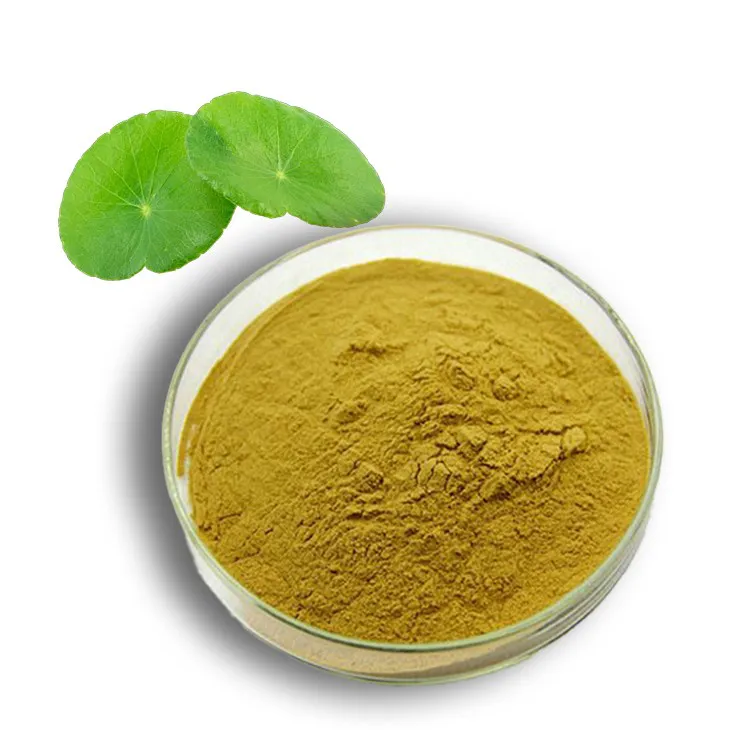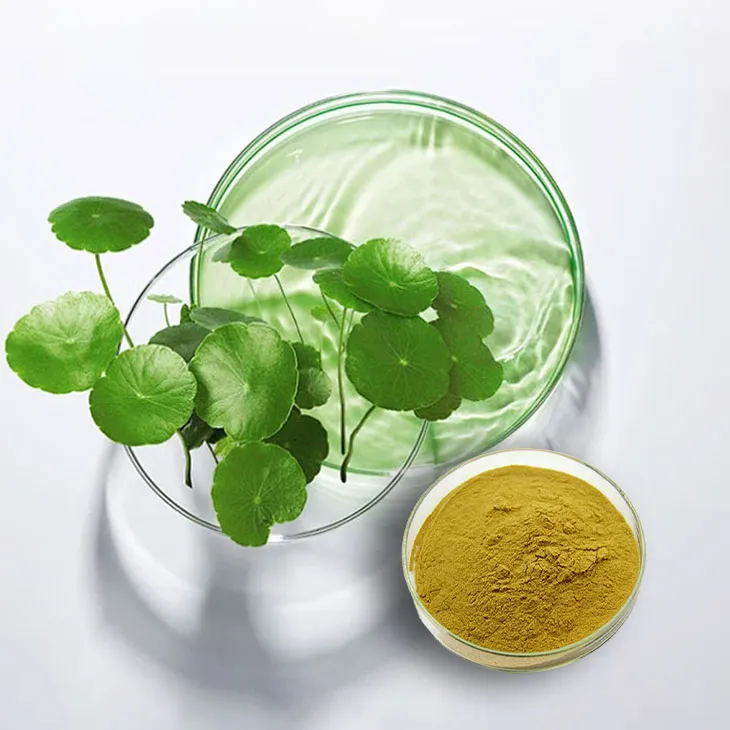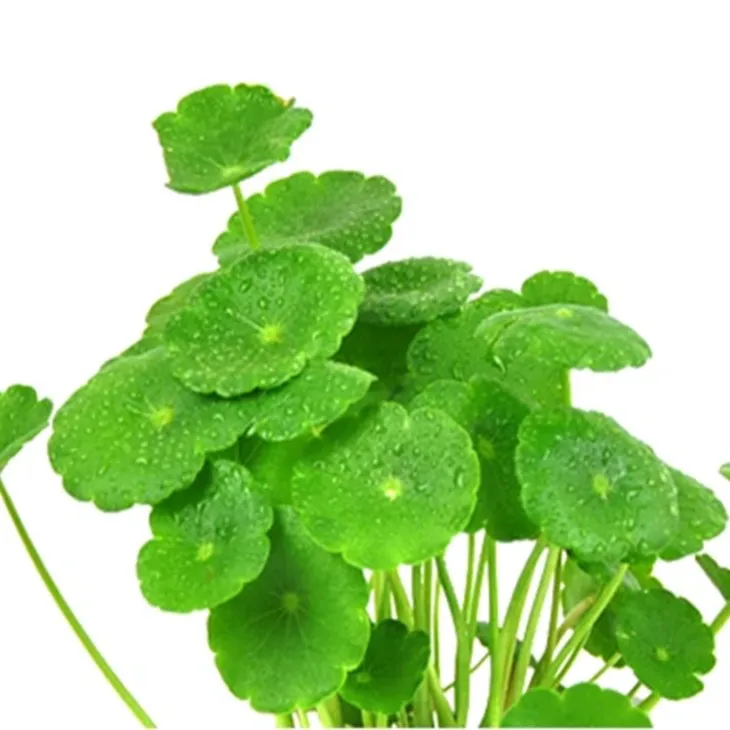- 0086-571-85302990
- sales@greenskybio.com
Extraction technology and production process of Centella asiatica extract.
2024-11-27

1. Introduction
Centella asiatica, a well - known medicinal plant, has been widely used in traditional medicine systems for centuries. The extract of Centella asiatica is highly valued due to its rich content of active components such as asiaticoside and madecassoside. These active components endow the extract with various beneficial properties, making it applicable in multiple industries, including cosmetics, pharmaceuticals, and food.

2. Active components in Centella Asiatica Extract
Asiaticoside: It is one of the major active components in Centella Asiatica Extract. Asiaticoside has been shown to have significant effects on wound healing, anti - inflammation, and promoting collagen synthesis. It plays a crucial role in the skin - repairing properties of Centella Asiatica Extract, which is widely used in cosmetics for skin rejuvenation and anti - aging products.
Madecassoside: Another important active ingredient. Madecassoside also exhibits strong anti - inflammatory and antioxidant activities. In the pharmaceutical field, it has the potential to be used in the treatment of various inflammatory diseases. In addition, in the food industry, it can be added as a functional ingredient to provide certain health - promoting effects.

3. Extraction technologies
3.1 Traditional solvent extraction
Principle: Traditional solvent extraction is based on the solubility of active ingredients in different solvents. Ethanol and methanol are commonly used solvents in the extraction of Centella asiatica extract. These solvents can dissolve asiaticoside, madecassoside and other active components from the raw materials of Centella asiatica.
Procedure:
- Raw material preparation: Select high - quality Centella asiatica plants, clean them thoroughly to remove dirt, impurities, and damaged parts.
- Grinding: Grind the prepared Centella asiatica into a suitable particle size. This step can increase the contact area between the raw material and the solvent, thereby improving the extraction efficiency.
- Extraction: Place the ground Centella asiatica in a solvent - containing extraction vessel. Stir the mixture continuously at a certain temperature and for a certain period of time to ensure that the active ingredients are fully dissolved in the solvent.
- Filtration: After the extraction is completed, filter the mixture to separate the liquid extract containing the active ingredients from the solid residue.
Advantages and disadvantages:
- Advantages: It is a relatively simple and cost - effective method. It can be carried out with common laboratory equipment, and is suitable for small - scale extraction in research and development or in small - scale production.
- Disadvantages: The extraction time is relatively long, and the selectivity of the solvent is not very high. It may extract some impurities together with the active ingredients, and the solvent residue in the final product may also be a concern, especially in applications where solvent residue requirements are strict, such as in the food industry.
3.2 Supercritical fluid extraction
Principle: Supercritical fluid extraction uses supercritical fluids as the extraction medium. In the case of Centella asiatica extraction, carbon dioxide is often used as the supercritical fluid. Supercritical carbon dioxide has properties between gas and liquid. It has a high diffusivity like a gas, which can quickly penetrate into the raw material, and at the same time, it has a certain solubility like a liquid, which can dissolve the target active ingredients.
Procedure:
- Pre - treatment of raw materials: Similar to traditional solvent extraction, the Centella asiatica raw materials need to be cleaned, dried, and ground to an appropriate particle size.
- Extraction system setup: The supercritical fluid extraction system consists of a carbon dioxide source, a pump, an extraction vessel, a separator, etc. Adjust the pressure and temperature of the system to make carbon dioxide reach the supercritical state.
- Extraction process: Feed the pre - treated Centella asiatica raw materials into the extraction vessel. Under supercritical conditions, carbon dioxide extracts the active ingredients from the raw materials. The extraction time and flow rate of carbon dioxide are adjusted according to the extraction requirements.
- Separation process: The mixture of supercritical carbon dioxide and the extracted active ingredients is sent to the separator. By adjusting the pressure and temperature in the separator, carbon dioxide is converted from the supercritical state back to the gaseous state and is separated from the active ingredients, obtaining the purified Centella asiatica extract.
Advantages and disadvantages:
- Advantages: It has high selectivity, can specifically extract the target active ingredients, and has high purity of the extract. The solvent (carbon dioxide) is non - toxic, non - flammable, and leaves little or no solvent residue in the final product, which is very suitable for applications in the food and pharmaceutical industries. In addition, the extraction process is relatively fast.
- Disadvantages: The equipment for supercritical fluid extraction is relatively expensive, and the operation and maintenance requirements are relatively high. It is more suitable for large - scale production to reduce the cost per unit of product.

4. Production process
4.1 Raw material pre - treatment
Harvesting: The timing of harvesting Centella asiatica is crucial. It should be harvested at the appropriate growth stage to ensure that the content of active ingredients is at the highest level. Generally, it is better to harvest when the plant is in its full - growth period.
Cleaning: After harvesting, the Centella asiatica needs to be thoroughly cleaned to remove soil, sand, and other contaminants. This step can be carried out by washing with clean water multiple times.
Drying: Drying is an important step to reduce the moisture content of the raw material. It can be dried naturally in a well - ventilated place or by using drying equipment such as a drying oven. The drying temperature should be controlled appropriately to avoid the destruction of active ingredients.
Grinding: Grinding the dried Centella asiatica into a suitable powder or particle size can increase the surface area for subsequent extraction operations. The particle size should be uniform to ensure the stability of the extraction process.
4.2 Extraction
As mentioned above, depending on the selected extraction technology (traditional solvent extraction or supercritical fluid extraction), the corresponding extraction procedures are carried out. The extraction process needs to control parameters such as temperature, time, solvent - to - raw - material ratio (in the case of traditional solvent extraction), and pressure (in the case of supercritical fluid extraction) to ensure the extraction efficiency and the quality of the extract.
4.3 Concentration
Evaporation: After extraction, the extract usually contains a large amount of solvent. Evaporation is a common method for concentration. By heating the extract under reduced pressure or normal pressure, the solvent is evaporated, and the concentration of the active ingredients in the extract is increased.
Membrane separation: Membrane separation technology can also be used for concentration. By using a semi - permeable membrane, the solvent can be separated from the active ingredients. This method has the advantages of low energy consumption and less damage to the active ingredients compared with evaporation.
4.4 Purification
Chromatography: Chromatography is a widely used purification method in the production of Centella asiatica extract. For example, high - performance liquid chromatography (HPLC) can effectively separate and purify asiaticoside, madecassoside and other active components from the extract, removing impurities and obtaining a high - purity extract.
Recrystallization: Recrystallization is another purification method. By dissolving the extract in a suitable solvent and then recrystallizing it under certain conditions, the purity of the active ingredients can be further improved.
5. Quality control in the production process
Raw material quality control:
- Identity verification: Use botanical identification methods to ensure that the raw material is indeed Centella asiatica, and not misidentified with other similar plants.
- Quality inspection of incoming materials: Check the moisture content, impurity content, and the content of active ingredients in the raw materials. Only raw materials that meet the quality standards can be used for production.
Process control:
- During the extraction process, regularly monitor and control parameters such as temperature, pressure, and time to ensure the stability of the extraction process and the consistency of the product quality.
- In the concentration and purification steps, also monitor relevant parameters such as the concentration degree and purification effect to ensure that the final product meets the quality requirements.
Final product quality inspection:
- Content determination of active ingredients: Use analytical methods such as HPLC to accurately determine the content of asiaticoside, madecassoside and other active ingredients in the final product, ensuring that they are within the specified range.
- Solvent residue inspection: For products using solvent extraction methods, especially those used in the food and pharmaceutical industries, it is necessary to strictly check the solvent residue to ensure that it meets the relevant safety standards.
- Microbial limit inspection: Check the microbial content in the product to ensure that it meets the hygiene standards for use in different industries.
6. Applications in different industries
6.1 Cosmetics industry
Centella asiatica extract is widely used in cosmetics due to its excellent skin - care properties. It can be added to various skin - care products such as creams, lotions, and serums.
- Anti - aging products: The asiaticoside and madecassoside in the extract can promote collagen synthesis, improve skin elasticity, and reduce the appearance of wrinkles, making it an ideal ingredient for anti - aging cosmetics.
- Wound - healing products: It has anti - inflammatory and wound - healing properties, which can be used in products for treating minor skin wounds, burns, and ulcers.
6.2 Pharmaceutical industry
In the pharmaceutical industry, Centella asiatica extract has potential applications in the treatment of various diseases.
- Anti - inflammatory drugs: Due to its anti - inflammatory activity, it can be developed as an ingredient in anti - inflammatory drugs for the treatment of inflammatory diseases such as arthritis.
- Neuroprotective drugs: Some studies have shown that it may have certain neuroprotective effects, and has the potential to be developed into drugs for the treatment of neurodegenerative diseases.
6.3 Food industry
As a natural plant extract, Centella asiatica extract can also be used in the food industry as a functional ingredient.
- Health - promoting products: It can be added to health foods such as dietary supplements, providing certain health - promoting effects such as antioxidant and anti - inflammatory functions.
- Beverage additives: It can be used as an additive in beverages, adding unique flavors and health - promoting functions.
7. Conclusion
The extraction technology and production process of Centella asiatica extract are crucial for obtaining high - quality extract with stable quality and efficacy. Different extraction technologies have their own advantages and disadvantages, and the production process needs to be strictly controlled in terms of raw material pre - treatment, extraction, concentration, and purification steps. Through high - quality production, Centella asiatica extract can be widely used in cosmetics, pharmaceuticals, and food industries, bringing more benefits to human health and beauty.
FAQ:
1. What are the main active components in Centella asiatica extract?
The main active components in Centella asiatica extract are asiaticoside, madecassoside, etc. These components contribute to the various properties and potential applications of the extract.
2. How does solvent extraction work for Centella asiatica extract?
Solvent extraction for Centella asiatica extract involves using solvents such as ethanol or methanol. The solvent is used to dissolve the active ingredients from the Centella asiatica raw materials. Through this process, the desired components are separated from the rest of the plant material.
3. What are the advantages of supercritical fluid extraction for Centella asiatica extract?
The supercritical fluid extraction method, with carbon dioxide as the supercritical fluid, has several advantages for Centella asiatica extract. It can produce extracts with high purity. Also, it results in less solvent residue compared to traditional extraction methods, which is beneficial for the quality of the final product.
4. Why are the steps in the production process of Centella asiatica extract important?
The steps in the production process of Centella asiatica extract, including raw material pre - treatment, extraction, concentration, and purification, are crucial. These steps ensure that the final extract has stable quality and efficacy. Each step plays a role in obtaining a high - quality extract suitable for applications in cosmetics, pharmaceuticals, and the food industry.
5. What are the potential applications of Centella asiatica extract?
Centella asiatica extract has potential applications in cosmetics, pharmaceuticals, and the food industry. In cosmetics, it may be used for skin - care products due to its beneficial effects on the skin. In pharmaceuticals, it could have properties relevant to certain medical treatments. In the food industry, it may be used as a natural ingredient with potential health - promoting properties.
Related literature
- Optimization of Centella asiatica Extract Production for Cosmetic Applications"
- "Supercritical Fluid Extraction of Active Compounds from Centella asiatica: A Review"
- "The Role of Centella asiatica Extract in Pharmaceutical Formulations"
- ▶ Hesperidin
- ▶ Citrus Bioflavonoids
- ▶ Plant Extract
- ▶ lycopene
- ▶ Diosmin
- ▶ Grape seed extract
- ▶ Sea buckthorn Juice Powder
- ▶ Fruit Juice Powder
- ▶ Hops Extract
- ▶ Artichoke Extract
- ▶ Mushroom extract
- ▶ Astaxanthin
- ▶ Green Tea Extract
- ▶ Curcumin
- ▶ Horse Chestnut Extract
- ▶ Other Product
- ▶ Boswellia Serrata Extract
- ▶ Resveratrol
- ▶ Marigold Extract
- ▶ Grape Leaf Extract
- ▶ New Product
- ▶ Aminolevulinic acid
- ▶ Cranberry Extract
- ▶ Red Yeast Rice
- ▶ Red Wine Extract
-
Aguaje Extract
2024-11-27
-
Saponin Extract
2024-11-27
-
Saw Palmetto Extract
2024-11-27
-
Mango flavored powder
2024-11-27
-
Yam Extract
2024-11-27
-
Acerola Extract
2024-11-27
-
Black Pepper Extract
2024-11-27
-
Agaricus Blazei Extract
2024-11-27
-
Baicalin
2024-11-27
-
American Ginseng Root Extract
2024-11-27





















